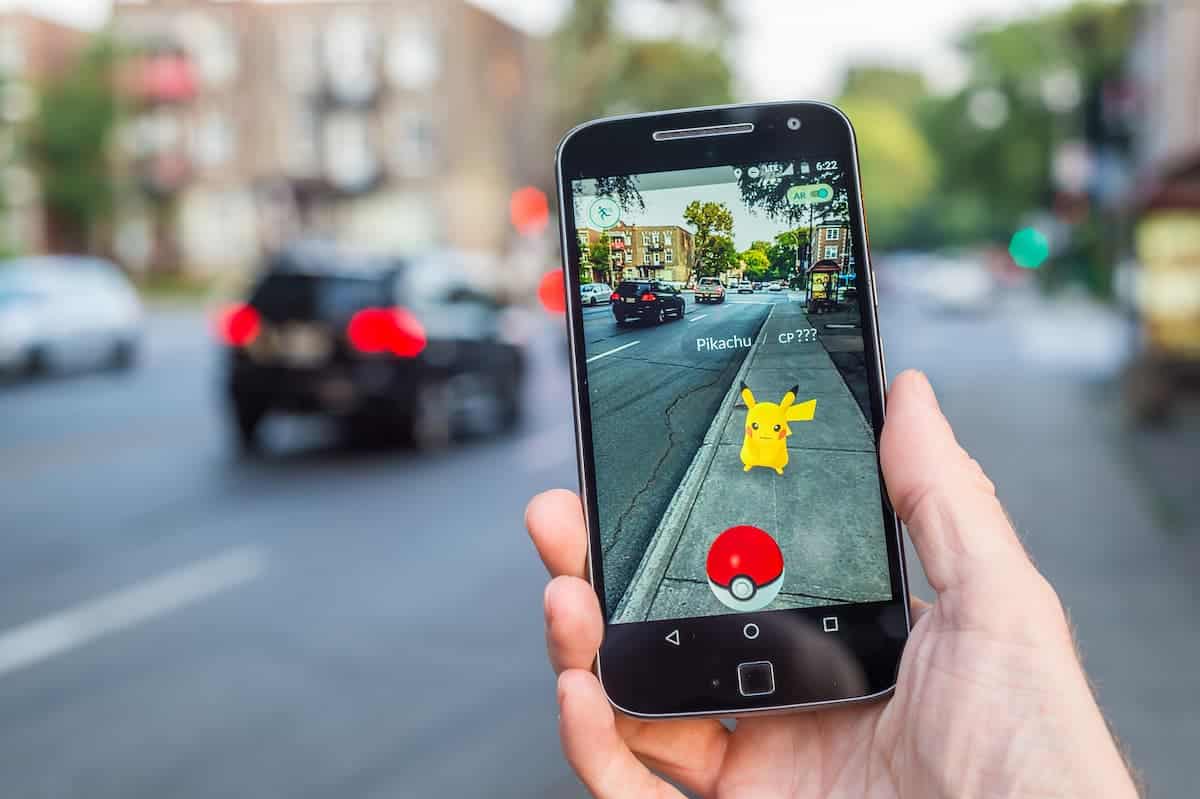Introduction
Augmented reality (AR) has transformed the way we experience digital content by seamlessly integrating virtual elements into the real world. One of the most popular examples of AR in recent years is the game Pokémon Go. Released in 2016, Pokémon Go took the world by storm, combining the excitement of the classic Pokémon franchise with the immersive power of augmented reality.
AR technology allows players to interact with virtual Pokémon creatures and objects in real-world locations. By using their smartphones or other compatible devices, players can explore their surroundings in search of Pokémon, battle other trainers, and discover hidden treasures, all within the context of their physical environment.
Pokémon Go’s innovative use of augmented reality has revolutionized the gaming industry, offering a unique and captivating gaming experience. Unlike traditional video games that confine players to a virtual world, Pokémon Go encourages users to step outside and explore their neighborhoods, parks, and landmarks.
This article will delve deeper into how Pokémon Go utilizes augmented reality technology, highlighting its real-world integration and interactive gameplay. We will also explore the benefits of augmented reality in gaming and discuss the challenges and limitations that this technology brings. By the end, you will have a comprehensive understanding of how a game like Pokémon Go is a prime example of the incredible potential that augmented reality holds for the gaming industry.
What is augmented reality?
Augmented reality (AR) is a technology that blends virtual elements with the real world, enhancing the user’s perception and interaction with their environment. Unlike virtual reality, which creates a completely immersive digital experience, augmented reality overlays computer-generated content onto the real world, seamlessly integrating virtual and physical elements.
AR technology relies on a combination of hardware and software to create this blended reality experience. It uses sensors, cameras, and GPS to track the user’s position and movements, allowing virtual objects to be anchored and interact with the real world in real-time.
The visual aspects of augmented reality are typically seen through the use of headsets, glasses, or mobile devices, such as smartphones or tablets. These devices display virtual content onto the user’s view, either through a transparent display or by overlaying digital images and information onto the device’s camera feed.
Augmented reality can serve various purposes, from entertainment and gaming to education, commerce, and navigation. With the advancement of AR technology, the possibilities for its application continue to expand, offering new and exciting ways to engage with digital information and experiences.
One key aspect of augmented reality is its ability to enhance the user’s perception of their physical surroundings. By overlaying virtual elements onto the real world, AR provides users with an enriched and interactive experience that combines the best of both digital and physical realms.
Furthermore, augmented reality allows for real-time interaction and manipulation of virtual objects within the physical environment. Users can engage with virtual content, move it around, and even modify it to create unique and personalized experiences.
Overall, augmented reality bridges the gap between the virtual and physical worlds, enabling users to explore, interact, and engage with digital content in a way that feels natural and immersive. With its growing accessibility and potential, augmented reality is set to become an integral part of our everyday lives, transforming the way we perceive and interact with the world around us.
How does Pokemon Go use augmented reality?
Pokemon Go is a prime example of how augmented reality can be seamlessly integrated into a gaming experience. The game utilizes AR technology to bring virtual Pokemon creatures into the real world, allowing players to interact with them in their physical environment.
When playing Pokemon Go, players use their smartphones or other compatible devices to explore their surroundings. The game’s AR capabilities utilize the device’s camera and GPS functionality to map virtual Pokemon onto the real-world locations. This means that players can see and interact with Pokemon as if they were actually present in their surroundings.
When encountering a wild Pokemon, players can physically move their device to change their perspective and view the Pokemon from different angles. The Pokemon even appear to scale with the environment, giving the illusion that they are inhabiting the world around the player.
Pokemon Go also incorporates real-world landmarks and points of interest as key locations in the game. These landmarks, such as parks, monuments, and popular gathering spots, become Pokemon Gyms or Pokestops. Players can battle at gyms, collect items, and engage with other players in these real-world locations.
The integration of augmented reality in Pokemon Go extends beyond just visual presentation. The game also utilizes augmented reality to enhance the capturing experience. When attempting to catch a Pokemon, players can turn on the AR mode, which presents the Pokemon on their device’s screen as if it were in their immediate physical space. Players can use their surroundings as reference points to throw Pokeballs and capture the Pokemon.
Pokemon Go’s use of augmented reality creates an immersive and interactive experience that blurs the lines between the virtual and physical worlds. By overlaying the Pokemon onto real-world locations, the game encourages players to explore their surroundings, fostering a sense of adventure and discovery.
It is worth noting that although augmented reality is a crucial aspect of the game, players also have the option to play without AR if they prefer a more traditional experience. However, the majority of players embrace the augmented reality aspect as it adds an extra layer of excitement and realism to their Pokemon Go journey.
Real-world integration in Pokemon Go
One of the defining features of Pokemon Go is its seamless integration of the real world into the gameplay experience. The game encourages players to explore their surroundings, turning familiar locations into exciting hunting grounds for virtual Pokemon creatures.
Pokemon Go utilizes real-world maps and locations to populate the game with Pokemon, Pokestops, and Gyms. These locations are often landmarks, parks, museums, and other points of interest in the player’s vicinity. This integration of real-world elements adds a sense of authenticity and familiarity to the game, making it feel like the Pokemon are truly coexisting in the player’s environment.
As players move around their surroundings, the in-game map updates in real-time, displaying new Pokemon nearby. This real-time tracking feature incentivizes players to explore their neighborhoods and communities, as different types of Pokemon can be found in various locations. It adds an element of excitement and discovery, as players never know what Pokemon they might encounter on their next adventure.
Pokemon Go also incorporates time and weather conditions into the gameplay. Different types of Pokemon are more likely to appear during specific times of the day or under certain weather conditions. For example, players may have a higher chance of encountering Water-type Pokemon near bodies of water or Electric-type Pokemon during thunderstorms.
In addition to capturing Pokemon, players can collect items, such as Pokeballs, potions, and berries, at Pokestops. These Pokestops are typically located at local landmarks or popular locations, encouraging players to visit and interact with their community. By integrating real-world points of interest as Pokestops, Pokemon Go promotes exploration and brings players together in shared physical spaces.
The integration of the real world in Pokemon Go extends beyond just landmarks and physical locations. The game also incorporates personal achievements and social interactions, such as joining teams and competing in Gym battles. Players can challenge other trainers in real-world locations that have been designated as Gyms, forming a sense of community and competition among players in their vicinity.
This real-world integration in Pokemon Go not only enhances the gameplay experience but also fosters a sense of connection to the player’s community. By exploring their surroundings and interacting with real-world locations and landmarks, players become more engaged with their environment and the people around them, creating a unique and immersive gaming experience.
Interactive gameplay in augmented reality
The interactive nature of augmented reality technology in games like Pokemon Go brings a whole new level of engagement to players. By utilizing the real world as the backdrop, augmented reality creates a unique and immersive gaming experience that encourages physical movement, social interaction, and strategic decision-making.
One of the key aspects of interactive gameplay in augmented reality is the physical movement required to play. In Pokemon Go, players need to physically explore their surroundings to find and capture Pokemon. This not only promotes physical activity but also incentivizes players to discover new places and engage with their environment in a meaningful way.
Furthermore, augmented reality gaming often encourages social interaction among players. In Pokemon Go, players can join teams, collaborate to defeat powerful Gym leaders, and participate in Raid battles. These features foster a sense of community and encourage players to connect with each other in the real world. The shared experience of playing the game in the same physical space enhances the social aspect and adds a new dimension to traditional multiplayer gaming.
Augmented reality also allows for dynamic and strategic decision-making within the gameplay. For instance, in Pokemon Go, players have to strategically choose which Pokemon to catch, which to evolve, and which to use in battles. The real-world environment and interactions add an element of unpredictability, as players must adapt their strategies based on the locations they visit and the types of Pokemon they encounter. This aspect of augmented reality gameplay adds depth and complexity to the gaming experience.
Additionally, augmented reality games often offer customization options, allowing players to personalize their virtual experiences. In Pokemon Go, players can choose to customize their avatar’s appearance, creating a unique representation of themselves within the game. This personalization adds a sense of ownership and allows players to express their individuality within the augmented reality world.
Interactivity in augmented reality gaming extends beyond the gameplay itself. Many games in this genre incorporate features that allow players to capture and share their experiences with others. In Pokemon Go, players can take screenshots of their captured Pokemon in various real-world locations, creating the opportunity to share their adventures on social media platforms and connect with other players who have had similar experiences.
Overall, the interactive gameplay in augmented reality offers a more immersive, socially engaging, and physically active experience for players. By utilizing the real-world environment as the foundation for gameplay, augmented reality games like Pokemon Go push boundaries and redefine traditional gaming experiences.
Benefits of augmented reality in gaming
The integration of augmented reality technology into gaming has brought numerous benefits and opportunities for both players and the gaming industry as a whole. Let’s explore some of the key advantages of augmented reality in gaming.
1. Immersive gameplay: Augmented reality creates a more immersive and realistic gaming experience by blending virtual elements with the real world. This immersion enhances player engagement and enjoyment, making the gaming experience more captivating and memorable.
2. Physical activity: Augmented reality games often require players to move around and explore their surroundings. This promotes physical activity and encourages players to lead more active lifestyles. Games like Pokemon Go have even been credited with getting people out and moving in ways they may not have otherwise.
3. Social interaction: Augmented reality games have a social aspect, bringing players together in the real world to play and interact. This fosters a sense of community and camaraderie as players collaborate, compete, and share experiences. Creating connections and friendships among players adds another layer of enjoyment and engagement to the gaming experience.
4. Real-world exploration: Augmented reality games encourage players to explore their surroundings and discover new locations. By incorporating real-world landmarks and points of interest, these games can lead players to explore places they may not have visited otherwise, promoting cultural, educational, and historical discovery.
5. Innovative gameplay mechanics: Augmented reality opens up new possibilities for creative and innovative gameplay mechanics. By blending virtual and physical elements, game developers can create unique and exciting challenges that are not possible in traditional video games. This innovation brings fresh and immersive experiences to players, keeping them engaged and eager to explore more.
6. Marketing and brand recognition: Augmented reality games provide opportunities for businesses to engage with customers in a unique and personalized way. By incorporating branded content or sponsored locations within the game, companies can increase brand recognition and reach a wider audience. This form of marketing allows for interactive and immersive experiences, creating a stronger bond between consumers and brands.
7. Educational value: Augmented reality games have the potential to provide educational benefits by incorporating informational content in an interactive and engaging manner. Players can learn about historical facts, geographic landmarks, scientific concepts, and more while enjoying the gaming experience. This gamified learning approach can make education more accessible, enjoyable, and memorable for players of all ages.
Overall, augmented reality in gaming offers a range of benefits, including immersion, physical activity, social interaction, exploration, innovation, marketing opportunities, and educational value. By harnessing the power of augmented reality, games can create unique and memorable experiences that go beyond the boundaries of traditional gaming.
Challenges and limitations of augmented reality in gaming
While augmented reality (AR) has brought significant advancements to the gaming industry, there are also several challenges and limitations associated with its implementation. Understanding these challenges can help developers and players alike navigate the potential drawbacks of augmented reality in gaming.
1. Technical constraints: One significant challenge of AR gaming is the technical limitations that arise from the need for advanced hardware and software. AR games require devices with powerful processing capabilities, high-resolution displays, and accurate sensors to deliver a seamless experience. These technical requirements can limit accessibility and increase the cost of entry for players.
2. Battery life and performance: The intensive use of processing power and graphics rendering in AR games can place a significant strain on device batteries, causing them to drain quickly. This can lead to shorter gameplay sessions and a dependency on consistent access to power sources. Additionally, some devices may struggle to maintain optimal performance while simultaneously running AR applications, leading to lags and decreased gameplay quality.
3. Safety concerns: The nature of AR gaming, which encourages players to move around and explore their surroundings, raises safety concerns. Players may become distracted by the game’s virtual elements and fail to pay attention to hazards in their environment, leading to accidents or injuries. It is essential for players to maintain situational awareness and exercise caution when engaging in AR gaming.
4. Data privacy and security: AR games often require access to personal data, such as location information, camera feeds, and device identifiers. This raises concerns about data privacy and the potential misuse of sensitive information. Game developers must prioritize the protection of user data and ensure that appropriate security measures are in place to safeguard player privacy.
5. Limited game worlds and environments: While AR technology enables the integration of virtual elements into the real world, the available game worlds and environments may still be limited compared to fully virtual gaming experiences. Factors such as geography, infrastructure, and cultural landmarks heavily influence the diversity and richness of the gaming experience. Players in less populated or remote areas may have a more limited selection of interactive elements and features.
6. Social and ethical implications: The social aspect of AR gaming can present challenges in terms of player behavior and societal impact. Instances of trespassing, disturbance of public spaces, or inappropriate behavior have been reported in some AR games. Game developers must consider the ethical implications of their game mechanics and encourage responsible gameplay to ensure a positive gaming experience for both players and the communities in which they interact.
7. Integration and compatibility: AR gaming relies on extensive integration of software and hardware components. This integration can result in compatibility issues between different devices and operating systems. Developers must optimize their applications to work seamlessly across a wide range of devices and ensure compatibility with future hardware and software updates.
Despite these challenges, ongoing advancements in technology and continued innovation in AR gaming are helping to address these limitations. As the technology evolves and becomes more accessible, developers and users can look forward to overcoming these challenges and unlocking the full potential of augmented reality in gaming.
Conclusion
Augmented reality has transformed the gaming industry, exemplified by popular games like Pokemon Go. By seamlessly integrating virtual elements into the real world, augmented reality offers a unique and immersive gaming experience that blurs the lines between the physical and digital realms.
Pokemon Go showcases how augmented reality can be effectively utilized in gaming. It incorporates real-world locations as Pokestops and Gyms, encourages physical movement and exploration, and fosters social interaction among players. The game brings the joy of discovering and capturing Pokemon into players’ everyday lives, making their own neighborhoods and communities the backdrop for their adventures.
The benefits of augmented reality in gaming are numerous. It provides immersive gameplay, promotes physical activity, encourages social interaction, and facilitates real-world exploration. Additionally, augmented reality offers innovative gameplay mechanics, marketing opportunities, and educational value.
However, there are also challenges and limitations associated with augmented reality gaming. These include technical constraints, battery life and performance issues, safety concerns, data privacy and security risks, limited game worlds, and social and ethical implications. Nonetheless, these challenges continue to be addressed through technological advancements and responsible development practices.
In conclusion, the integration of augmented reality in gaming opens up new possibilities and creates unique experiences for players. With ongoing advancements and innovations, augmented reality is poised to revolutionize the gaming industry, immersing players in captivating and interactive worlds that blend seamlessly with their physical surroundings. The future of augmented reality gaming holds tremendous potential, offering endless opportunities for exploration, creativity, and social connection.

























